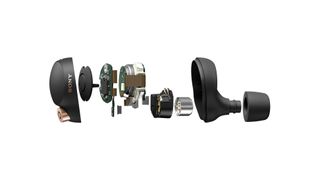Not sure whether to buy the new Sony WF-1000XM4 or save money with the older Sony WF-1000XM3? Well we can help. We looked at both of Sony’s true wireless earbuds and we can safely say which of the two is worth your money.
What makes it difficult is that if you had asked us six months ago before we knew about the Sony WF-1000XM4, we would have told you that the WF-1000XM3 are honestly the best true wireless earbuds out there . Now things are less clear.
What the Sony WF-1000M4 offers is superior noise-canceling technology thanks to the new built-in V1 processor, which replaces the QN1 noise-canceling processor in the WF-1000XM3, and Sony’s DSEE Extreme software, which upscales low-resolution audio files better.
In addition to these top-line features, the WF-1000M4 has slightly longer battery life (eight hours versus six hours per charge) and a waterproof IPX4 rating that makes it better to take to the gym. Last but not least, they are smaller and use new earplugs that adapt to the shape of your ear canal and feel more comfortable during longer listening sessions.
So is the Sony WF-1000XM4 a better choice? Not always. They cost over $ 100 more, and that has left a lot of people wondering if it is worth upgrading to the WF-1000XM4 or if they should just stick with the cheaper WF-1000XM3 from 2019 that Prime Day It’s coming up soon in 2021, and that means the older WF-1000XM3 could be scaled down quite a bit in the near future.
The choice will be different for everyone. However, so that you can better understand which model is right for you, we have listed the most important differences below.
(Image credit: Sony)
Difference # 1: The noise suppression is better on the Sony WF-1000XM4
Of all the reasons to upgrade to the Sony WF-1000XM4, one of the biggest is its better noise cancellation. Thanks to the new integrated processor V1, the WF-1000XM4 is able to drastically reduce incoming noise in almost every audible frequency range. This means you’ll hear less engine noise when flying and less noise when sitting at your desk in a busy office. There’s also a new windshield that makes the buds better at blocking out ambient noise on a windy day – which is actually super handy.
In addition to the new processor, Sony also includes new noise isolation earbud tips, which contribute to a more stable fit and offer better noise isolation than the previous model. They essentially feel like foam earbuds, and it is likely that you can purchase some third-party brands for the WF-1000XM3 in the future. So you’re not the only reason to upgrade, but your addition to this year’s model is welcome.
(Image credit: Sony)
Difference # 2: The sound quality is better better with the Sony WF-1000XM4
The other main reason to upgrade is of course to improve sound quality, largely thanks to DSEE Extreme software, which better processes lower quality audio sources and upscales them for playback. This is the same technology we saw on Sony’s WH-1000XM4 over-ear headphones last year, and it’s pretty effective at its job.
As for the actual drivers, Sony still uses 6mm drivers on the WF-1000MX4, but these have been fundamentally improved for better bass response. It definitely feels that way after the test – but don’t expect overwhelming bass, as the overall sound profile is still relatively neutral.
(Image credit: Sony)
Difference # 3: The Sony WF-1000XM4 supports LDAC for Hi-Res Audio Wireless
Speaking of sound quality, a technical advantage of the WF-1000XM4 over the WF-1000XM3 is the addition of Sony’s LDAC codec, which supports streaming up to 990 kbps – roughly three times as fast as the standard SBC codec.
This extra bandwidth can help the WF-1000XM4 get a little closer to true Hi-Res audio status (although they aren’t quite there yet) and make your music sound more detailed than if you were listening to it through the WF-1000XM3 . But first you need to make sure you have an Android device that supports LDAC. (Sorry, iPhone owners, not you.)
(Image credit: Sony)
Difference # 4: The Sony WF-1000XM4 has a slightly longer battery life
It’s not a huge difference, but the Sony WF-1000XM4 has a slightly longer battery life than the WF-1000XM3 by around two hours per charge. According to Sony, the WF-1000XM4 should last around eight hours on a charge, compared to the six hours of the WF-1000XM3 – but the case itself still only lasts 24 hours of battery life.
What does that mean for you? You can work with it for a full day, but be ready to recharge it every few days.
(Image credit: Sony)
Difference # 5: The Sony WF-1000XM4 are IPX4 waterproof
Another small difference is that the WF-1000XM4 are waterproof. An IPX4 rating means the WF-1000XM4 can withstand a splash of water and is usually safe to take to the gym. After testing them at the end of the Covid-19 pandemic, we haven’t had the chance to go to the gym with them ourselves, but protection is pretty standard and should withstand rain too.
That being said, neither earbud is completely waterproof – unlike the Samsung Galaxy Buds Pro, which has an IPX7 rating – so keep them away from the pool so they don’t fall in and can’t be recovered.
(Image credit: Sony)
Difference # 6: The WF-1000XM4 buds and charging case are smaller
If size is important to you, the WF-1000XM4 are significantly smaller than the WF-1000XM3. According to Sony, the earbuds are about a 10% size difference and the charging case a whopping 40%. That means they’re easier to carry in your pocket without taking up a lot of space, and they may feel a little more comfortable in your ear.
(Image credit: Sony)
Difference # 7: The WF-1000XM4 supports wireless charging
If you want to be on the cutting edge of technology, the new WF-1000XM4 case supports wireless charging via a Qi charger. We had one on hand from our last test of the Amazon Echo Buds (2nd generation) and found that it also worked moderately well for the WF-1000XM4. It seems to take a little longer to charge it this way, but it came in handy to put it on the charging pad every night instead of trying to track down the included USB-C charging cable.
(Image credit: Sony)
Difference # 8: The WF-1000XM4 are significantly more expensive
OK, here’s the main reason not to jump on the new Sony WF-1000XM4: they’re going to start at $ 279 / £ 250 / AU $ 499.95. That’s $ 100 / £ 100 / AU $ 300 more than the current WF-1000XM3 is sold at places like Amazon. Considering that the WF-1000XM3 is going to keep dropping for the next several months, and well, it’s getting really hard to decide between two pretty great true wireless earbuds.
The other problem with the price of the WF-1000XM4 is that there are other really good earbuds out there that offer many of the same features for a lot less money. For example, there’s the new Amazon Echo Buds (2nd Gen), which offer noise cancellation for just $ 129, and even the relatively expensive AirPods Pro are cheaper in most places at $ 199 / £ 199 / AU $ 399 . We’ll be providing a full guide to Apple AirPods Pro vs. Sony WF-1000XM4 shortly for a full comparison, but you can see how you can save if you’re willing to leave out some features.
(Image credit: Sony)
Are there any similarities between the WF-1000XM4 and the WF-1000XM3?
At this point, it may seem like the WF-1000XM3 is nothing redeeming, while the WF-1000XM4 are some kind of true wireless noise-canceling marvels broadcast by the audio gods themselves – but nothing could be further from the truth be. The Sony WF-1000XM3 has been high on our list of the best true wireless earbuds for the past two years – and they’ll rank high on that list even now that the WF-1000XM4 is here.
That’s because these earbuds basically do the same things. Both offer some levels of audio upscaling and noise cancellation, as well as decent battery life and a comfortable design that allows you to wear them for long periods of time. They both do these things better than almost any other true wireless earbud on the market, and use the same app, so you really wouldn’t go wrong with buying one, especially if your money is tight.
(Image credit: Sony)
So which one should you buy?
Without knowing your particular situation, it is difficult for us to say. But if you are someone who needs extra strong active noise cancellation or is looking for better audio quality because the sound of your songs is very important to you, then you are probably better off paying the extra cash on the Sony WF-1000XM4.
However, if all you want is some level of noise cancellation and audio upscaling, and not all the fancy extras like wireless charging and LDAC, you can probably save a ton of money by buying the older WF-1000XM3. They’re still damn good earbuds – some of the best, honestly – so there’s no shame in picking them up to save some cash.
Of course, we encourage you to read both our Sony WF-1000XM4 review and our Sony WF-1000XM3 review to find out even more, but hopefully you know a little more now than you did five minutes ago.











